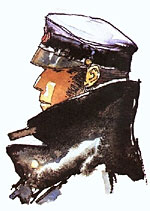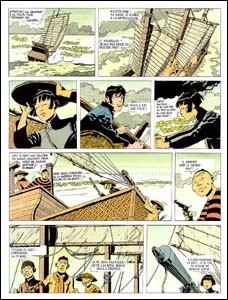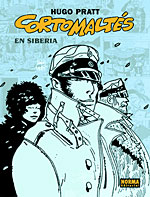>> Beyond Borders: Mondo Loco
>> Beyond Borders: Every Picture Tells A Story
More...

This is adventure. Danger, love, something to fight for.
To the connoisseur of European comics, the name Hugo Pratt is as sacred of the names Jack Kirby to an American superhero reader, or R Crumb to an indie 'comix' fan. It is more than just a name. It is legend.
An adventurer and soldier turned cartoonist, Pratt built a gallery of romantic heroes mixing the old French swashbuckling brand of heroes with 20th century ideology and attitude. Dumas meets Bakunin. These are bitter men who can't help but be idealistic despite their contempt toward the human race; disgruntled figures swept up by the tides of history and forced to act on their ideals not because they want to, but because they feel it's the right thing to do. In Pratt's world, altruism is a sickness and we have no cure for it.
Pratt was born near Rimini, Italy, in 1927, right in the middle of the Italian fascist revolution. He lived in Venice as a child, a city that marked him as no other, soaking him in his aura of magic and romance. Soon he moved to Ethiopia with his family, which was then an Italian colony, and fell in love with Africa, a love that he showed repeatedly in his work.
In 1944, after the Italian defeat in Ethiopia, he moved back to Venice, where he was mistaken for a South African spy and arrested by the SS. Not wanting to enlist with the Germans, he joins the allies to work as an interpreter.
As soon as the war ended, he started working as a cartoonist, but the lack of opportunities to build a career in his own country made him move to Argentina, then the country of hope for many Europeans, which harboured a fertile comics scene where people like Breccia, Oesterheld and Solano López were creating some of the greatest masterpieces of comics history. There he quickly paired with Argentinean maestro HG Oesterheld and contributed pencils to Westerns like SERGEANT KIRK or TICONDEROGA. He also started to cultivate his long lasting love for war series, starting with the superb war-journalism series ERNIE PIKE.
And suddenly, he found his own artistic voice, which combined a rich taste for adventure and exoticism with 19th century romanticism and sense of wonder. From then on, he would almost exclusively write his own stories - and score a few masterpieces in the process.
 His style, at first very influenced by American master Milton Caniff, shifted from the clear line of the American cartoonists and the Franco-Belgian masters to a detailed and atmospheric mix of heavy-inked lines and watercolour spots, with the inking focused not in backgrounds, but in characters themselves and in the set pieces. Pratt used thick blacks to enhance expression and mood, a move that was soon to be emulated and taken further by Argentinean masters like Breccia and Carlos Muñoz, the forefathers of modern masters like Frank Miller, Mike Mignola and Eduardo Risso.
His style, at first very influenced by American master Milton Caniff, shifted from the clear line of the American cartoonists and the Franco-Belgian masters to a detailed and atmospheric mix of heavy-inked lines and watercolour spots, with the inking focused not in backgrounds, but in characters themselves and in the set pieces. Pratt used thick blacks to enhance expression and mood, a move that was soon to be emulated and taken further by Argentinean masters like Breccia and Carlos Muñoz, the forefathers of modern masters like Frank Miller, Mike Mignola and Eduardo Risso.
This evolution in Pratt's style can be clearly seen in works like the adventure romp ANA DE LA JUNGLA and WHEELING, a sequel to the frontier Western TICONDEROGA. But it was not until 1960, when he moved back to Europe, that he finally got the financial backing he needed to start his own magazine and write his own stories. The magazine was called SERGEANT KIRK, and that was where the legend of Corto Maltese, his most famous character, was born.
Until his death in 1995, Pratt alternated Corto adventures with scattered work for Italian and French publishers, like VERANO INDIO (1983) and GAUCHO (1991) - both with superb and typically kinky art by glorious pervert Milo Manara - and his own solo efforts, CATO ZULU (1984) and LES ESCORPIONS DU DESERT (several volumes from 1975 to 1980), arguably one of the best war comics ever created.
So who is Corto?
Well, just think of Indiana Jones - but far more irresistibly roguish and handsome. Oh, and more morally ambiguous. And anarchistic. And... well, there are layer after layer of different traits that bring Corto to life. He's one of the most complex characters in comics, because while you never know what he's going to do next, his behaviour is never random; he always acts in accordance with his own philosophy and does what he thinks is right. That's when he has a say in it, at least. A lot of the time Corto just gets caught up in the whirlwind of someone else's circumstances, and ends up coolly smoking a cigarette while he waits for the firing squad to end his fully lived life.
Corto is an adventurer. He first appears as a castaway, crucified to a mast by his former crew in the middle of the Pacific. At first he's a villain of sorts; a pirate at the service of a mysterious monk, who preys on commercial vessels on the Pacific. But soon the reader realises that his actions aren't quite that black and white, and neither are those of his friend, enemy, rival, and sometime companion Rasputin.
 Rasputin represents Corto's dark side, what he could become if he didn't have a moral philosophy (and was as crazy as a rabid monkey). Rasputin is largely motivated by his thirst for wealth, though there are other layers to his disturbing personality.
Rasputin represents Corto's dark side, what he could become if he didn't have a moral philosophy (and was as crazy as a rabid monkey). Rasputin is largely motivated by his thirst for wealth, though there are other layers to his disturbing personality.
But most of the time Corto travels alone, and his roaming takes him all over the world. One of the major peculiarities of the series was Pratt's apparent disregard for linear narrative. Corto's first appearance, BALLAD OF SALTY WATER, is not the start of his story. Pratt jumps back and forth across Corto's story, telling us about his first taste of war in the Boxer's rebellion in China; how he met Jack London and Rasputin during the Russian-Japanese War; and his encounters with Butch Cassidy and the Sundance Kid in Argentina in 1904, or Stalin in Ancona, Italy in 1907. He also visits Africa during World War I, witnesses the death of Manfred von Richthofen, and, in 1918, takes part in a train heist in Siberia.
CORTO MALTESE IN SIBERIA can be considered the finest album in the series because it features everything great about the Corto universe. Under a loose plot involving the heist of an armoured train loaded with tsarist gold stolen from the communists by rebel traditionalist General Kolchak, Pratt shows us the chaotic politics of post-revolutionary Russia and Asia.
The gold (and the balance of power in the region that it represents) is anxiously coveted by the Chinese triads, Asian warlords, Mongolian and Maoist communist revolutionaries, Bolsheviks, white Russians, Japanese, and Corto Maltese and Rasputín.
There's also a tragic and insanely beautiful Russian countess and femme fatale, a chain-smoking impetuous American pilot, a treacherous Chinese general, and the deranged, mystical, apocalyptic and homicidal Baron Roman von Ungern-Sternberg, who believes he is the descendant of Genghis Khan and wants to create a Pan-Eurasian empire and eradicate Bolshevism off the face of Earth.
 In 80 pages of beautifully painted, frantic action, we move from China to Mongolia, then to Central Asia, witnessing train heists, revolutionary warfare, shooting squads, ancient Buddhist seers, cold blooded murders and Rasputin's joyous murders. It's hard to think of many other books so crammed with action, and the art is nothing less than breathtaking throughout.
In 80 pages of beautifully painted, frantic action, we move from China to Mongolia, then to Central Asia, witnessing train heists, revolutionary warfare, shooting squads, ancient Buddhist seers, cold blooded murders and Rasputin's joyous murders. It's hard to think of many other books so crammed with action, and the art is nothing less than breathtaking throughout.
Pratt's distinct character design and excruciating eye for detail are matched by the strength of his storytelling technique and the depth of his understanding of character. His stories are true masterpieces that should be in every school library, because they're not only phenomenal adventure tales; they also offer a detailed glimpse of the world during a decisive and turbulent time in human history.
After Siberia, Corto has further adventures, searching for the lost treasure of Alexander the Great and Atlantis, or meeting Hermann Hesse... until he disappears in the Spanish Civil War in 1936, while fights the fascist uprising.
He didn't die, though. Like all true romantic heroes, Corto simply vanishes in the mist, promising future, untold travels and escapades that are left to our imaginations.
Pratt chose to let Corto disappear because he felt than in the electronic and materialistic age we live on, heroes like Corto have no place. Untrue. In the darkest times, we need people like Corto. True romantics who fight on no matter the consequences; the old breed of tired heroes with grey ideologies. We don't need goodie two-shoes heroes. I like my role models complicated and my femmes fatale. Life is not very interesting in black and white.
If you choose to dive into the marvellous world of Corto and the rest of Pratt's work, your best hope is to buy the French editions. Published by Casterman, each volume contains an 80-page single story of actual story, plus lovely introductory artwork, character sketches and watercolour pin-ups, as well as interviews, articles and exhaustive research material. Pratt originally published the series in black and white, but he approved and supervised the colour work. (Avoid the cheap volumes, based on magazine reprints, badly cut and re-edited, which altered the original artwork significantly.)

This article is Ideological Freeware. The author grants permission for its reproduction and redistribution by private individuals on condition that the author and source of the article are clearly shown, no charge is made, and the whole article is reproduced intact, including this notice.


